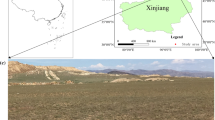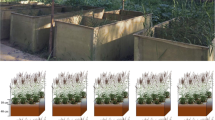Abstract
Some soils in the Yueliangbao gold mining area have been contaminated by heavy metals, resulting in variations in vegetation. Hyperspectral remote sensing provides a new perspective for heavy metal inversion in vegetation. In this paper, we collected ground truth spectral data of three dominant vegetation species, Miscanthus floridulus, Equisetum ramosissimum and Eremochloa ciliaris, from contaminated and healthy non-mining areas of the Yueliangbao gold mining region, and determined their heavy metal contents. Firstly, we compared the spectral characteristics of vegetation in the mining and non-mining areas by removing the envelope and derivative transformation. Secondly, we extracted their characteristic identification bands using the Mahalanobis distance and PLS-DA method. Finally, we constructed the inverse model by selecting the vegetation index (such as the PRI, DCNI, MTCI, etc.) related to the characteristic band combined with the heavy metal content. Compared to previous studies, we found that the pollution level in the Yueliangbao gold mining area had greatly reduced, but arsenic metal pollution remained a serious issue. Miscanthus floridulus and Eremochloa ciliaris in the mining area exhibited obvious arsenic stress, with a large “red-edge blue shift” (9 and 6 nm). The extracted characteristic wavebands were around 550 and 680–740 nm wavelengths, and correlation analysis showed significant correlations between vegetation index and arsenic, allowing us to construct a prediction model for arsenic and realize the calculation of heavy metal content using vegetation spectra. This provides a methodological basis for monitoring vegetation pollution in other gold mining areas.






Similar content being viewed by others
Data availability
The data that support the findings of this study are available on request from the corresponding author. The data are not publicly available due to privacy or ethical restrictions.
Change history
28 September 2023
A Correction to this paper has been published: https://doi.org/10.1007/s10653-023-01753-y
References
Banerjee, B. P., et al. (2017). Health condition assessment for vegetation exposed to heavy metal pollution through airborne hyperspectral data. Environmental Monitoring and Assessment, 189(12), 1–11.
Boyd, D. S., et al. (2011). Phenology of vegetation in Southern England from Envisat MERIS terrestrial chlorophyll index (MTCI) data. International Journal of Remote Sensing, 32(23), 8421–8447.
Cai, T., & Tang, H. (2011). A review of least-squares fitting principles for smooth filters. Digital Communication, 38(01), 63–68.
Chen, B., Han, H., Wang, F., et al. (2013). Monitoring chlorophyll and nitrogen contents in cotton leaf infected by Verticillium wilt with spectra red edge parameters. Journal of Crop Science, 39(02), 319–329.
Chen, P. F., et al. (2010). New spectral indicator assessing the efficiency of crop nitrogen treatment in corn and wheat. Remote Sensing of Environment, 114(9), 1987–1997.
Chen, S., Zhou, C., Wang, J., et al. (2012). Vegetation stress spectra and their relations with the contents of metal elements within the plant leaves in metal mines in Heilongjiang. Spectroscopy and Spectral Analysis, 32(05), 1310–1315.
Clevers, J., et al. (2004). Study of heavy metal contamination in river floodplains using the red-edge position in spectroscopic data. International Journal of Remote Sensing, 25(19), 3883–3895.
Dawson, T. P., & Curran, P. J. (1998). A new technique for interpolating the reflectance red edge position. International Journal of Remote Sensing, 19(11), 2133–2139.
Defries, R. S., & Townshend, J. R. G. (1994). NDVI-derived land-cover classifications at a global-scale. International Journal of Remote Sensing, 15(17), 3567–3586.
Gao, L., Yang, G., Yu, H., et al. (2016a). Retrieving winter wheat leaf area index based on unmanned aerial vehicle hyperspectral remote sensing. Transactions of the Chinese Society of Agricultural Engineering, 32(22), 113–120.
Gao, P., Gao, P., Sun, W., et al. (2022). Response of the Endosphere and Rhizosphere microbial community in Petris vittata L. to Arsenic stress. Journal of Ecology and Environment, 31(06), 1225–1234. https://doi.org/10.16258/j.cnki.1674-5906.2022.06.019
Gao, S., Lin, J., Ma, T., et al. (2018). Extraction and analysis of Hyperspectral data and characteristics from Pedicularis on Bayanbulak grassland in Xinjiang. Remote Sensing Technology and Application, 33(05), 908–914.
Gao, Y., Peng, Z., Qiu, H., et al. (2016b). Determination of heavy metal elements in dominant plants from Hubei Zigui Yueliangbao gold mine tailings with ICP-OES. Analysis Laboratory, 35(05), 521–525. https://doi.org/10.13595/j.cnki.issn1000-0720.2016.0120
Gitelson, A. A., et al. (2005). Remote estimation of canopy chlorophyll content in crops. Geophysical Research Letters. https://doi.org/10.1029/2005GL022688
Gitelson, A. A., et al. (2014). Relationships between gross primary production, green LAI, and canopy chlorophyll content in maize: Implications for remote sensing of primary production. Remote Sensing of Environment, 144, 65–72.
Guo, B., et al. (2021). Estimating socio-economic parameters via machine learning methods using Luojia1-01 nighttime light remotely sensed images at multiple scales of China in 2018. Ieee Access, 9, 34352–34365.
Guo, B., Bai, H., Zhang, B., et al. (2022). Inversion of soil zinc contents using hyperspectral remote sensing based on random forest and continuous wavelet transform in an opencast coal mine. Journal of Agricultural Engineering, 38(10), 138–147.
Haboudane, D., et al. (2004). Hyperspectral vegetation indices and novel algorithms for predicting green LAI of crop canopies: Modeling and validation in the context of precision agriculture. Remote Sensing of Environment, 90(3), 337–352.
Huang, N., et al. (2012). Relationships between soil respiration and photosynthesis-related spectral vegetation indices in two cropland ecosystems. Agricultural and Forest Meteorology, 160, 80–89.
Ju, C. H., et al. (2010). Estimating leaf chlorophyll content using red edge parameters. Pedosphere, 20(5), 633–644.
Khosravi, V., et al. (2021). Satellite imagery for monitoring and mapping soil chromium pollution in a mine waste dump. Remote Sensing, 13(7), 1277.
Kooistra, L., et al. (2004). Exploring field vegetation reflectance as an indicator of soil contamination in river floodplains. Environmental Pollution, 127(2), 281–290.
Lee, L. C., et al. (2018). Partial least squares-discriminant analysis (PLS-DA) for classification of high-dimensional (HD) data: A review of contemporary practice strategies and knowledge gaps. The Analyst, 143(15), 3526–3539.
Liu, Q., Wang, C., Wang, R., et al. (2018). Hyperspectral qualitative identification on latent period of wheat stripe rust. Journal of Plant Protection, 45(01), 153–160. https://doi.org/10.13802/j.cnki.zwbhxb.2018.2018916
Liu, X., Yang, G., Chen, H., et al. (2020). Spectral characteristics of plant-soil mixture with spectral reflection measurement. Journal of Northeast Forestry University, 48(02), 54–60. https://doi.org/10.13759/j.cnki.dlxb.2020.02.010
Qiao, X., Ma, S., Hou, H., et al. (2018). Hyper-spectral features of heavy metal pollutants in vegetables and their inversion model in the mining areas. Journal of Safety and Environment, 18(01), 335–341. https://doi.org/10.13637/j.issn.1009-6094.2018.01.063
Rabal, H., et al. (2012). Holodiagrams using Mahalanobis distance. Optik, 123(19), 1725–1731.
Rondeaux, G., et al. (1996). Optimization of soil-adjusted vegetation indices. Remote Sensing of Environment, 55(2), 95–107.
Rosso, P. H., et al. (2005). Reflectance properties and physiological responses of Salicornia virginica to heavy metal and petroleum contamination. Environmental Pollution, 137(2), 241–252.
Roujean, J. L., & Breon, F. M. (1995). Estimating par absorbed by vegetation from bidirectional reflectance measurements. Remote Sensing of Environment, 51(3), 375–384.
Shi, C., Huang, C., Li, S., et al. (2020). Spectral characteristics and correlation of heavy metal and vegetationcover stress in Fanshan copper-molybdenum. Geological Science and Technology Bulletin, 39(03), 202–210. https://doi.org/10.19509/j.cnki.dzkq.2020.0322
Shuai, Q., Huang, S., Li, Z., et al. (2015). The metal element information extraction from Hyperion data based on the vegetation stress spectra. Earth Science (journal of China University of Geosciences), 40(08), 1319–1324.
Sims, D. A., & Gamon, J. A. (2002). Relationships between leaf pigment content and spectral reflectance across a wide range of species, leaf structures and developmental stages. Remote Sensing of Environment, 81(2–3), 337–354.
Smith, K. L., et al. (2004). Use of hyperspectral derivative ratios in the red-edge region to identify plant stress responses to gas leaks. Remote Sensing of Environment, 92(2), 207–217.
Sun, W. C., et al. (2019). Heavy metal pollution at mine sites estimated from reflectance spectroscopy following correction for skewed data. Environmental Pollution, 252, 1117–1124.
Sun, Y., Zhang, J., Jia, P., et al. (2020). Spectral characteristics of different vegetations on saline-alkali land in the Northern Yinchuan Plain of Ningxia. Journal of Northwest Agriculture and Forestry University of Science and Technology, 48(11), 143–154. https://doi.org/10.13207/j.cnki.jnwafu.2020.11.016
Sun, Z. (2018). Preliminary Study on Inversion of Soil Copper Content Based on Leaf Spectra of High Vegetation Coverage Area in Mines. China university of geosciences.
Vogelmann, J. E., et al. (1993). RED edge spectral measurements from sugar maple leaves. International Journal of Remote Sensing, 14(8), 1563–1575.
Wang, J. Z., et al. (2019). Capability of Sentinel-2 MSI data for monitoring and mapping of soil salinity in dry and wet seasons in the Ebinur Lake region, Xinjiang, China. Geoderma, 353, 172–187.
Wen, Y., Zhang, D., Wang, J., et al. (2022). Estimation of chlorophyll content in Populus euphratica leaves based on hyperspectral data. Western Forestry Science, 51(04), 87–95. https://doi.org/10.16473/j.cnki.xblykx1972.2022.04.013
Wu, N., Liu, J., Yan, R., et al. (2012). Spectral reflectance feature in canopy of Pinus massoniana cercospora needle blight and severity level inversion. Chinese Agronomy Bulletin, 28(04), 51–57.
Xu, Y., Hu, G., & Zhang, Z. (2005). Continuum removal and its application to the spectrum classification of field object. Geography and Geographic Information Science, 06, 11–14.
Xu, Y., Hu, G., & Zhang, Z. (2010). Object identification of hyperspectral image based on the spectral overall shape and local absorption-band Positions. Journal of Wuhan, 35(07), 868–872. https://doi.org/10.13203/j.whugis2010.07.027
Yang, L., Gao, X., Zhang, W., et al. (2016). Estimating heavy metal concentrations in topsoil from vegetation reflectance spectra of Hyperion images: A case study of Yushu County, Qinghai, China. Journal of Applied Ecology, 27(06), 1775–1784. https://doi.org/10.13287/j.1001-9332.201606.030
Yu, K., et al. (2018). Vegetation reflectance spectroscopy for biomonitoring of heavy metal pollution in urban soils. Environmental Pollution, 243, 1912–1922.
Zarate-Valdez, J. L., et al. (2012). Prediction of leaf area index in almonds by vegetation indexes. Computers and Electronics in Agriculture, 85, 24–32.
Zhang, F., Li, R., Zhou, M., et al. (2014). Spectral reflectance characteristics of typical Halophytes in the Oasis Salinization-Desert zone in middle reaches of Tarim River. Geography and Geographic Information Science, 30(04), 12–17.
Zhou, W., Li, H., Shi, P., et al. (2020). Spectral characteristics of vegetation of poisonous weed degraded grassland in the Three-River Headwaters region. Journal of Geo-Information Science, 22(8), 1735–1742. https://doi.org/10.12082/dqxxkx.2020.190606
Acknowledgements
Thanks to the State Key Laboratory of Biogeology and Environmental Geology, China University of Geosciences (Wuhan) for providing experimental support.
Funding
This independent research was Supported by the International Research Center of Big Data for Sustainable Development Goals (CBAS2022GSP05); Open Fund of State Key Laboratory of Remote Sensing Science (Grant No. 6142A01210404); Hubei Key Laboratory of Intelligent Geo-Information Processing (Grant No. KLIGIP-2022-B03); Metallogenic patterns and mineralization predictions for the Daping gold deposit in Yuanyang County, Yunnan Province (Grant No. 2022026821); Ministry of Education Industry-University Cooperation Collaborative Education Project—Remote Sensing Practical Education and Science Popularization Base Construction (Grant No. 20221008).
Author information
Authors and Affiliations
Contributions
LW Mainly responsible for collecting field data, providing financial support for the project, and giving comments on the first draft of the paper. TY Mainly responsible for research and analysis of measurement data, research literature and methods, and writing the first draft of the paper. LF Mainly responsible for field data collection, providing ideas for thesis supervision and financial support. GY Mainly responsible for providing technical support on computer. WX Mainly responsible for providing financial support for projects and other technical support. SJ Mainly responsible for providing instrumentation and other technical support.
Corresponding author
Ethics declarations
Conflict of interest
The authors declare that they have no conflict of interest.
Additional information
Publisher's Note
Springer Nature remains neutral with regard to jurisdictional claims in published maps and institutional affiliations.
The original online version of this article was revised: The authors first and last name are interchanged correctly.
Rights and permissions
Springer Nature or its licensor (e.g. a society or other partner) holds exclusive rights to this article under a publishing agreement with the author(s) or other rightsholder(s); author self-archiving of the accepted manuscript version of this article is solely governed by the terms of such publishing agreement and applicable law.
About this article
Cite this article
Lin, W., Tu, Y., Liu, F. et al. Spectral characteristics of the correlation between elemental arsenic and vegetation stress in the Yueliangbao gold mining. Environ Geochem Health 45, 8203–8219 (2023). https://doi.org/10.1007/s10653-023-01693-7
Received:
Accepted:
Published:
Issue Date:
DOI: https://doi.org/10.1007/s10653-023-01693-7




